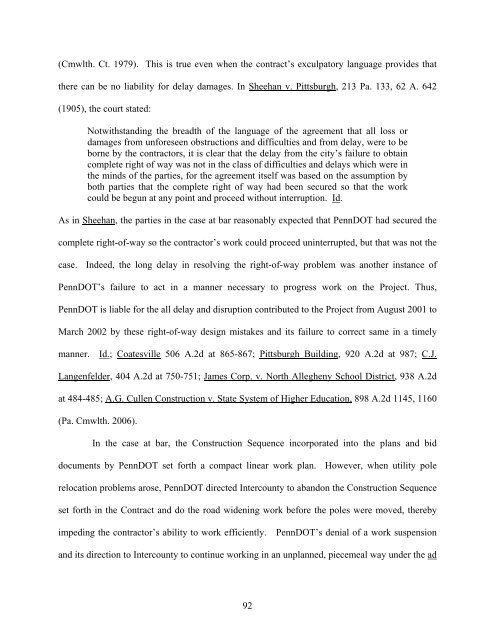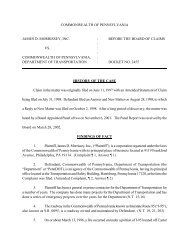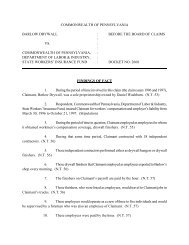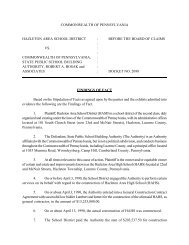3720 - Board of Claims
3720 - Board of Claims
3720 - Board of Claims
You also want an ePaper? Increase the reach of your titles
YUMPU automatically turns print PDFs into web optimized ePapers that Google loves.
(Cmwlth. Ct. 1979). This is true even when the contract’s exculpatory language provides that<br />
there can be no liability for delay damages. In Sheehan v. Pittsburgh, 213 Pa. 133, 62 A. 642<br />
(1905), the court stated:<br />
Notwithstanding the breadth <strong>of</strong> the language <strong>of</strong> the agreement that all loss or<br />
damages from unforeseen obstructions and difficulties and from delay, were to be<br />
borne by the contractors, it is clear that the delay from the city’s failure to obtain<br />
complete right <strong>of</strong> way was not in the class <strong>of</strong> difficulties and delays which were in<br />
the minds <strong>of</strong> the parties, for the agreement itself was based on the assumption by<br />
both parties that the complete right <strong>of</strong> way had been secured so that the work<br />
could be begun at any point and proceed without interruption. Id.<br />
As in Sheehan, the parties in the case at bar reasonably expected that PennDOT had secured the<br />
complete right-<strong>of</strong>-way so the contractor’s work could proceed uninterrupted, but that was not the<br />
case. Indeed, the long delay in resolving the right-<strong>of</strong>-way problem was another instance <strong>of</strong><br />
PennDOT’s failure to act in a manner necessary to progress work on the Project. Thus,<br />
PennDOT is liable for the all delay and disruption contributed to the Project from August 2001 to<br />
March 2002 by these right-<strong>of</strong>-way design mistakes and its failure to correct same in a timely<br />
manner. Id.; Coatesville 506 A.2d at 865-867; Pittsburgh Building, 920 A.2d at 987; C.J.<br />
Langenfelder, 404 A.2d at 750-751; James Corp. v. North Allegheny School District, 938 A.2d<br />
at 484-485; A.G. Cullen Construction v. State System <strong>of</strong> Higher Education, 898 A.2d 1145, 1160<br />
(Pa. Cmwlth. 2006).<br />
In the case at bar, the Construction Sequence incorporated into the plans and bid<br />
documents by PennDOT set forth a compact linear work plan. However, when utility pole<br />
relocation problems arose, PennDOT directed Intercounty to abandon the Construction Sequence<br />
set forth in the Contract and do the road widening work before the poles were moved, thereby<br />
impeding the contractor’s ability to work efficiently. PennDOT’s denial <strong>of</strong> a work suspension<br />
and its direction to Intercounty to continue working in an unplanned, piecemeal way under the ad<br />
92






